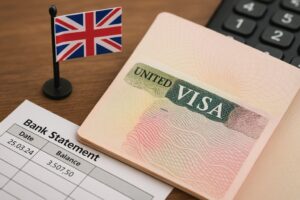
Applying for a UK spouse visa involves a long list of requirements, but one of the most commonly overlooked is the translation of financial documents. If your bank statements aren’t in English or Welsh, they must be professionally translated and certified. Otherwise, your application may not even be considered.
That might sound like a technicality, but it’s not. This one step can have serious consequences if you get it wrong.
The Role of Bank Statements in Your Visa Application
Bank statements are one of the main ways to prove that you meet the financial requirements for a UK spouse visa. These requirements are strict and non-negotiable. If you’re relying on income or savings from outside the UK, those records must be fully understood by UK immigration officers.
This means that anything written in another language must be translated in full. It doesn’t matter how simple or familiar the document seems: if it’s not in English or Welsh, the Home Office will not accept it unless the translation meets very specific rules.
What the Translation Must Include
The Home Office has clear guidelines on what an acceptable translation looks like. You can’t simply translate it yourself or ask a bilingual friend. They want to see a certified translation that ticks every box:
- A full and accurate translation of the entire document, not just key parts or summaries
- A signed statement from the translator confirming it’s a true and correct translation
- The translator’s full name, qualifications and contact details
- The date of the translation
If even one of these elements is missing, the Home Office may reject your application. That can lead to delays or worse, a refusal.
Mistakes That Could Cost You
Many people are caught off guard by how strict the standards are. It’s not uncommon for applications to be refused over something as simple as an incomplete or unofficial translation. Here are some of the most frequent errors:
Some submit bank statements with only part of the content translated, thinking it’s enough to show the income or final balance. Others send translations that don’t include the translator’s name or credentials. Some applicants use automated translation tools or informal translators, which are not accepted under any circumstances.
Even formatting can cause problems. If the layout of the translation doesn’t clearly reflect the original, the document might be flagged as unclear or suspicious.
More Than Just Numbers on a Page
It’s easy to think of bank statements as plain evidence of money, but UKVI sees more than just figures. They analyse patterns of deposits, employer names, account ownership, and other indicators of stable financial support. If they can’t understand the content clearly, your financial position may be questioned.
For example, regular income, consistent payment dates, and clear employer names can all work in your favour. But if that information is buried in a foreign-language document with no proper translation, it becomes meaningless in the eyes of the visa officer. This is why a clear, certified bank statement translation is essential to prove your eligibility.
When You Might Need Translation (Even If You’re Fluent)
Just because you speak English doesn’t mean your documents do. There are plenty of situations where a certified translation is still needed:
- If your salary is paid into a non-English bank account
- If you have savings in a foreign currency account
- If your partner is named on a joint account in another country
- If you’ve recently switched banks and need to include statements from multiple places
- If you’re submitting financial records from a previous job overseas
- If your supporting bank documents include letters or summaries in another language
Even if you’re including just a few months of non-English statements, those pages still need to be translated in full and certified.
How to Get It Right
Timing matters. Leaving translation until the last minute creates pressure, and there’s no room for error in this part of the application.
Here’s what you can do to stay on track:
- Plan ahead – Start organising translations early in the process so you’re not rushing near your submission date.
- Use a reputable translator – Make sure they provide all the required certification details, not just the translation itself.
- Check the formatting – The layout of the translation should match the original, including transaction dates, amounts and account numbers.
- Keep both copies – Submit the original document and the translation side by side to avoid confusion.
Getting this right the first time saves time, money and a lot of unnecessary stress.
Why Cutting Corners Can Backfire
There’s a temptation to skip formal translation, especially if you’re confident about what the statements say. But the Home Office won’t take your word for it, and they won’t accept informal translations under any condition.
Think of it this way: an official translation is not just a formality. It’s your proof that the financial evidence you’re providing is complete, legitimate and easy to verify. If anything about your documents is unclear, your whole application could be undermined.
And it’s not just about reapplying. A refusal can also affect your immigration history, which makes future applications more complicated.
Translation Isn’t Optional, It’s Strategic
Every piece of your UK spouse visa application needs to meet strict requirements, and your financial documents are no exception. If your bank statements aren’t in English or Welsh, the translation must be accurate, complete and certified. There’s no flexibility around this.
Skipping or mishandling this step can put your entire application at risk. But by getting it right, you show the Home Office that you’ve prepared carefully and that your financial situation is clear, stable and reliable.
It’s a small detail with a big impact. Give it the attention it deserves.





